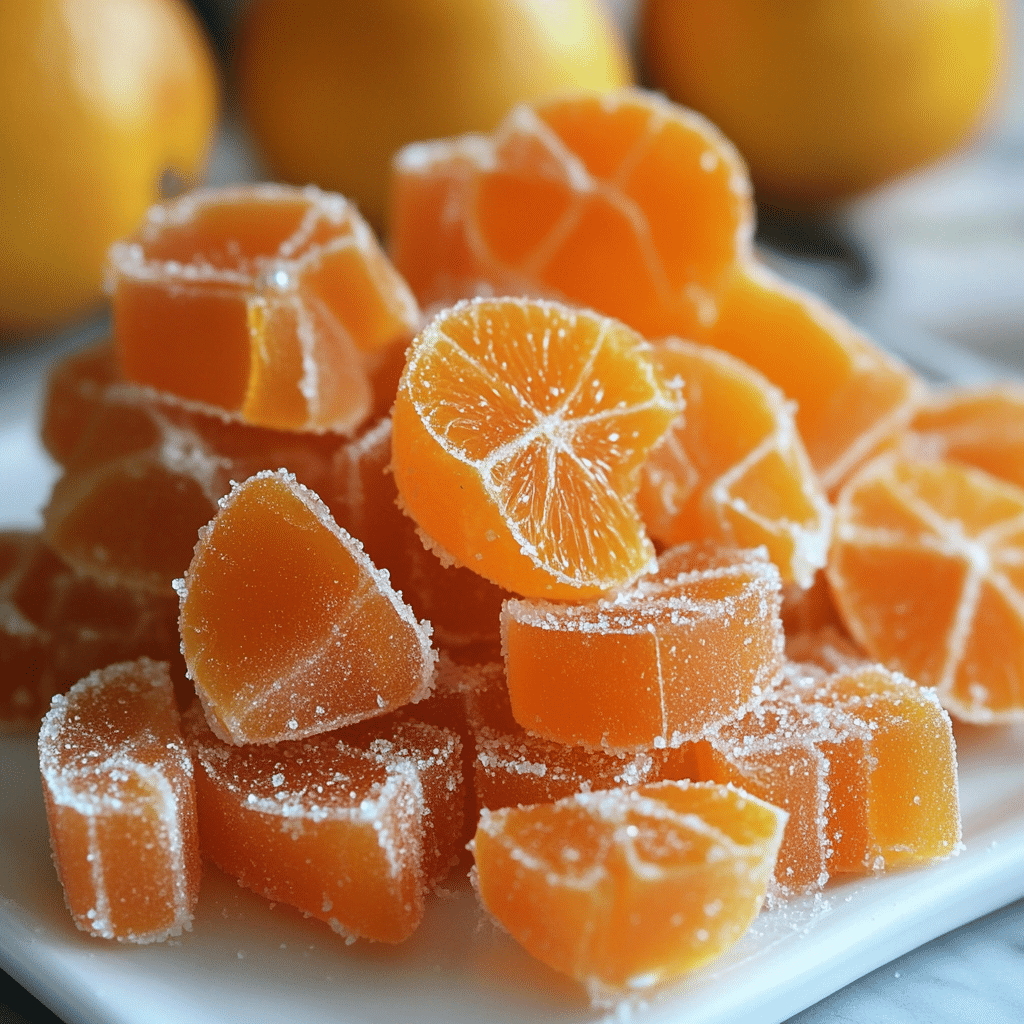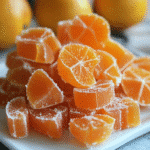Homemade candy never goes out of style and Classic Homemade Orange Candy is one sweet treat that hits all the right notes: tangy, citrusy, chewy, and satisfying. Whether you’re a candy-lover looking to ditch the preservatives or a DIY enthusiast who loves cooking from scratch, learning how to make this nostalgic treat is both fun and rewarding.
In this article, you’ll explore everything from the origins and types of orange candies to expert techniques for candying oranges at home. You’ll also find time-saving tricks, health considerations, storage tips, and even ideas to gift your homemade creations.
Table of Contents
Table of Contents
1. Introduction to Classic Homemade Orange Candy
What is Classic Homemade Orange Candy?
At its core, classic homemade orange candy is a sugary treat made by boiling slices or peels of oranges in a simple syrup until they become tender, translucent, and deliciously sweet. Unlike store-bought versions, homemade orange candy often retains more of the fruit’s original flavor, texture, and tanginess.
There are many variations of orange candy from chewy citrus slices to hard candies and jelly-style sweets. What makes it “classic” is the balance between sugar and citrus that keeps you coming back for more. Typically, it includes minimal ingredients: oranges, sugar, water, and sometimes a dash of lemon juice or vanilla for added depth.
The Timeless Popularity of Orange-Flavored Candies
Orange has long been a favorite flavor in the candy world. From vintage candy stores to modern gourmet brands, the bright taste of citrus appeals to both kids and adults alike. It’s not just the flavor it’s the cheerful color and natural freshness that makes orange candies so visually and emotionally appealing.
Candy companies have been using orange as a go-to flavor in mixed fruit assortments, gummy slices, sour belts, and more. But homemade versions offer a rustic charm that’s hard to beat and the added perk of controlling every ingredient that goes into it.
2. Benefits of Making Orange Candy at Home
Natural Ingredients vs. Artificial Flavors
One of the most rewarding aspects of making classic homemade orange candy is that you have full control over what goes into it. Store-bought candies often contain artificial flavors, synthetic food dyes, and preservatives that might not align with your health goals. By going the homemade route, you’re working with real oranges fresh juice, zest, and peels all of which contribute to a more vibrant and authentic citrus flavor.
You can also swap out refined sugar for natural sweeteners like honey or coconut sugar, making the treat slightly more wholesome. Unlike mass-produced orange candy, your homemade batch won’t have any hidden chemicals or unpronounceable ingredients.
Healthier Options and Portion Control
Making candy at home naturally helps you control portion sizes and reduce unnecessary additives. You decide how much sugar to use, how many candies to prepare, and how big each piece should be. That’s a huge win if you’re watching your sugar intake or trying to manage calories.
Additionally, incorporating fresh orange juice or zest offers trace amounts of vitamin C, fiber, and antioxidants nutrients that don’t typically survive the industrial candy-making process.
For those with dietary restrictions or allergies, homemade candy allows for flexible substitutions. Whether you’re aiming for vegan, gluten-free, or low-glycemic versions, the options are entirely in your hands.
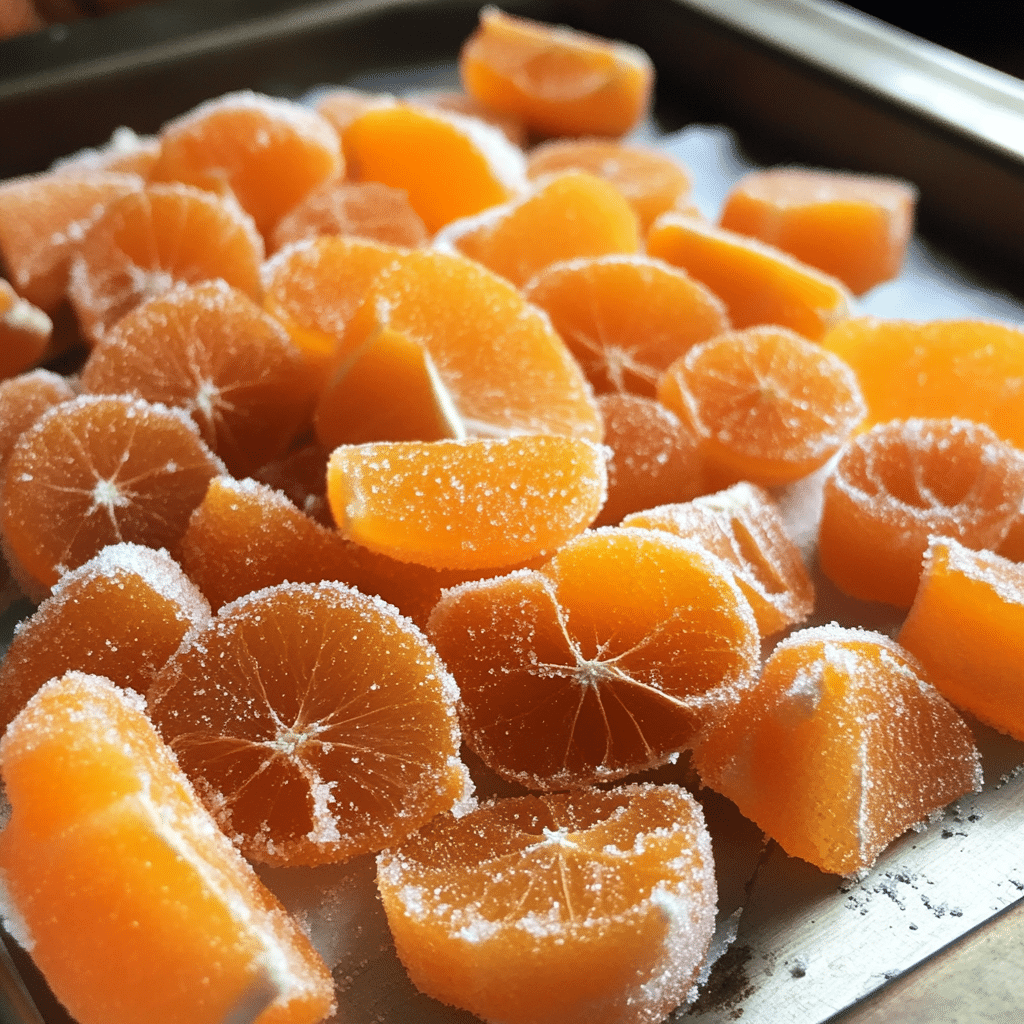
3. Essential Ingredients and Tools for Homemade Orange Candy
Fresh Oranges, Sugar, and Other Core Ingredients
The simplicity of classic homemade orange candy lies in its minimal ingredient list. To get that nostalgic, zesty flavor just right, you only need a few essentials:
| Ingredient | Purpose |
|---|---|
| Fresh oranges (preferably seedless) | Provides the base flavor and texture |
| Granulated sugar | Sweetens and preserves the orange peels |
| Water | Used to create a simple syrup |
| Lemon juice (optional) | Enhances the citrus profile and balances sweetness |
| Vanilla extract (optional) | Adds a warm, aromatic note |
| Corn syrup (optional) | Prevents crystallization in some variations |
You can also experiment with blood oranges or tangerines for a twist in color and flavor. Choosing organic oranges is ideal since you’ll often be candying the peels, which are more susceptible to pesticide residue.
Equipment You’ll Need in Your Kitchen
Making orange candy at home doesn’t require a professional kitchen, but a few basic tools will make the process smoother and more consistent.
| Tool | Use |
|---|---|
| Sharp knife and cutting board | For slicing oranges evenly |
| Medium saucepan or pot | Ideal for boiling syrup and simmering peels |
| Candy thermometer | Ensures the sugar reaches the proper stage (optional, but useful) |
| Fine mesh strainer | For draining excess syrup |
| Baking sheet with parchment | Used for drying or baking the candies |
| Cooling rack or dehydrator (optional) | For quick and even drying |
If you plan to make these candies regularly, investing in silicone candy molds or a sugar spinner may open the door to fancier presentations.
4. How to Make Classic Homemade Orange Candy – Step-by-Step Guide
Preparing the Oranges for Candying
Preparation is key when making classic homemade orange candy. To begin, thoroughly wash your oranges—especially if you’re using the peels. Organic oranges are preferred, but if you’re using conventional ones, soak them briefly in a vinegar-water solution to reduce pesticide residue.
Here’s how to prep:
- Peel the oranges using a sharp knife or peeler. You can also use the whole orange slices, but peel strips are the most classic approach.
- Remove excess pith (the white part under the skin), as too much can add bitterness.
- Slice the peel into even strips—about 1/4 inch wide is standard for chewy candied orange peel.
If using slices of the fruit itself, ensure they’re thin and even for consistent candying.
Cooking Process: From Peel to Sweet Perfection
Once your orange peels or slices are ready, it’s time to candy!
Step-by-Step Candying Process:
- Blanch the peels (or slices) in boiling water for 2–3 minutes to soften and reduce bitterness. Repeat this 2–3 times, changing the water each time.
- Make a simple syrup: Combine 1 cup water and 1 cup granulated sugar in a saucepan over medium heat. Stir until sugar dissolves.
- Add the orange peels to the syrup. Simmer uncovered for 45–60 minutes until the peels turn translucent.
- Drain and dry: Use a slotted spoon to remove the peels and place them on a wire rack or parchment-lined baking tray.
- Optional coating: Roll the peels in granulated sugar for extra texture.
- Let dry completely—at least 4–6 hours at room temperature or speed it up in a low oven (200°F) for 1 hour.
5. Quick Methods to Candy Oranges
Time-Saving Hacks for Busy Cooks
Making classic homemade orange candy from scratch doesn’t have to take all day. While the traditional stovetop simmering method gives the richest flavor, there are faster techniques that still deliver a satisfying result.
Here are a few shortcuts:
- Use a microwave to candy slices: Place thinly sliced oranges or peels in a microwave-safe dish, cover with simple syrup, and cook in short bursts (1–2 minutes at a time) until the syrup thickens and the fruit is translucent. Total time: 10–12 minutes.
- Parboil only once: If you’re okay with a slightly more bitter flavor, skip multiple blanching rounds and parboil the orange peels just once before simmering in syrup.
- Freeze dry or oven dry: Instead of waiting for 6+ hours of air drying, use a low-temp oven (200°F) or a food dehydrator to dry candies in under an hour.
These time-saving tricks won’t compromise the flavor too much and are ideal when you’re prepping candies for a last-minute gift or event.
Microwave and Oven Techniques Explained
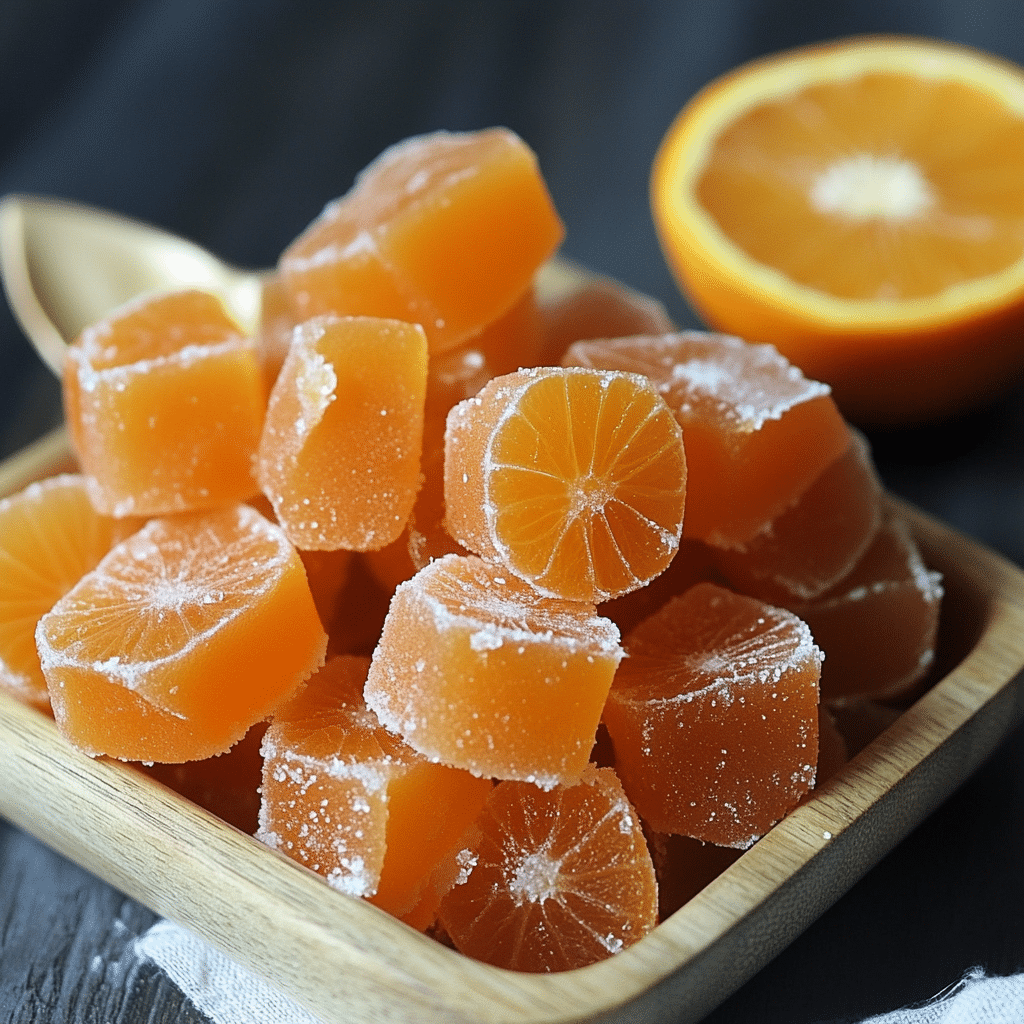
Microwave Candying Instructions:
| Step | Description |
|---|---|
| Slice oranges thinly | About 1/8″ for best results |
| Place in syrup | Cover with a mix of 1 part sugar, 1 part water |
| Microwave in intervals | Heat for 1–2 minutes, stir, repeat until translucent |
| Cool & sugar-coat | Let cool slightly, roll in sugar, and dry on parchment |
Oven Candying Method:
| Step | Description |
|---|---|
| Preheat oven | Set to 200°F (93°C) |
| Prepare slices or peels | Dip in syrup or roll in sugar |
| Bake on parchment | Lay flat on lined tray, bake 45–60 minutes |
| Let cool | Remove and cool before storage |
Both methods are perfect when you’re short on time but still want to enjoy that chewy, tangy sweetness.
6. Different Types of Orange Candies You Can Make
Orange Slices, Hard Candies, and Jelly-Style Sweets
When it comes to classic homemade orange candy, there’s no one-size-fits-all version. The term covers a variety of sweet creations, each with its own texture and preparation method. Let’s explore the most popular types:
1. Candied Orange Slices
Thin slices of whole orange, simmered in syrup and then dried. These retain a rich citrus aroma, chewy texture, and slightly bitter-sweet finish from the peel.
2. Candied Orange Peel Strips
These are strips of peel (zest and a little pith) that are boiled, sweetened, and sometimes rolled in sugar or dipped in chocolate. They offer a tangy punch and chewy consistency that candy lovers adore.
3. Orange Jelly Candies
A kid favorite, these jellied versions mimic the texture of commercial orange gummies but with more citrus integrity. They’re made by combining orange juice with gelatin or agar-agar, sugar, and pectin for that wiggly delight.
4. Orange Hard Candies
These involve heating sugar to a hard-crack stage, adding orange extract or juice, and pouring into molds. They’re clear, glossy, and perfect for sucking.
5. Orange Caramels and Toffees
A twist on classic caramels—these include orange zest or extract to infuse a creamy caramel base with citrus notes. Perfect for a richer candy experience.
Which Orange Candy Is Best for You?
Your perfect match depends on taste, texture, and occasion:
| Type | Best For |
|---|---|
| Candied orange slices | Holiday gifts, cake toppers |
| Peel strips | Snacking, chocolate-dipping |
| Jelly candies | Kids’ treats, party favors |
| Hard candies | Long-lasting, elegant presentation |
| Orange caramels | Gourmet gifts, indulgent snacking |
Whether you want something chewy, crunchy, or gummy, orange has you covered. The best part? All of these can be made at home using fresh ingredients and minimal tools.
7. Is Orange Candy Healthy? Nutritional Facts and Considerations
Calories, Sugar Content, and Alternatives
Like any candy, classic homemade orange candy is meant to be enjoyed in moderation. While it’s certainly sweeter than eating a raw orange, homemade versions have an edge: you control the sugar.
A typical serving of candied orange peel (about 1 oz) contains:
| Nutrient | Approximate Value |
|---|---|
| Calories | 130–160 kcal |
| Sugar | 25–30g |
| Fat | 0g |
| Fiber | 1–2g |
| Vitamin C | Trace amounts remain after cooking |
The sugar content is high because candying requires a saturated syrup. However, by adjusting the sugar ratio or using alternatives like coconut sugar, honey, or stevia, you can create a slightly healthier version.
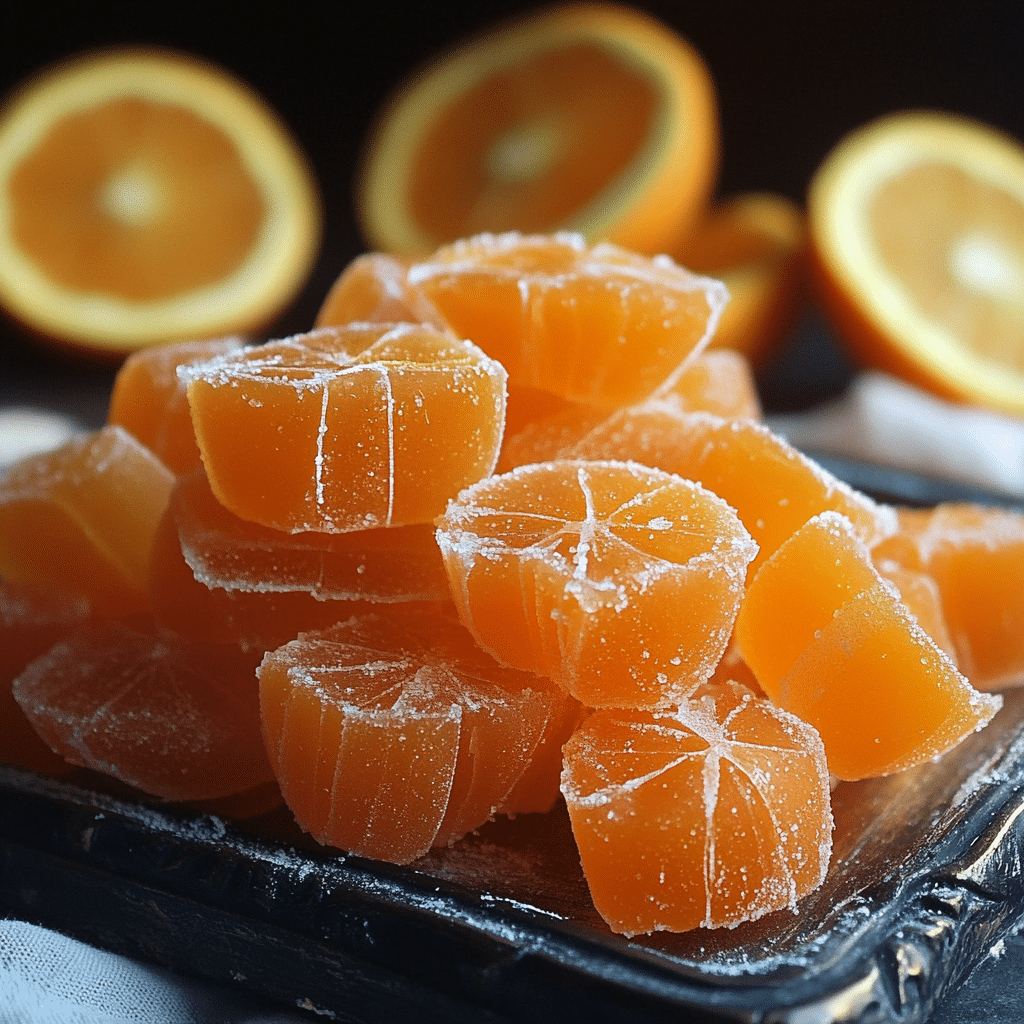
Tips for Making Low-Sugar or Organic Versions
- Choose organic oranges: Especially if you’re using the peel, this helps avoid pesticide residue.
- Skip the sugar coating: Let the orange pieces dry naturally after cooking for a cleaner finish.
- Use natural sweeteners: Agave syrup, monk fruit, or erythritol work well in candy recipes with some adjustments.
- Avoid artificial colorants: Oranges are vibrant enough on their own. Let the fruit’s natural glow shine.
Even though orange candy is a treat, it’s still more wholesome than store-bought versions packed with preservatives and synthetic flavors. And when made with mindfulness, it can be part of a balanced lifestyle.
8. How to Store and Serve Homemade Orange Candy
Storage Tips for Freshness and Flavor
Proper storage is key to keeping your classic homemade orange candy tasting fresh and delicious for weeks. Since these candies contain natural sugars and fruit oils, exposure to moisture or air can lead to stickiness, crystallization, or spoilage.
Here’s how to store them the right way:
| Method | Shelf Life | Notes |
|---|---|---|
| Airtight glass jar | 2–3 weeks | Keep in a cool, dry pantry |
| Refrigeration | Up to 1 month | Great for humid climates |
| Freezing | Up to 3 months | Layer with wax paper to prevent sticking |
Make sure the candy is completely dry before storing any moisture will lead to quick spoilage or mold. Use parchment paper between layers to prevent them from clumping together.
Packaging for Gifts or Special Occasions
Homemade orange candy makes a charming, budget-friendly gift for birthdays, holidays, or party favors. With a little creativity, you can package your citrus delights in a way that looks just as good as they taste.
Creative packaging ideas:
- Mini mason jars with ribbon and custom labels
- Cellophane treat bags sealed with twine and a citrus-scented tag
- Vintage tins for a nostalgic feel
- Recycled candy boxes lined with parchment and stickers
Add a personal touch by including a handwritten recipe card or note. You can even pair them with tea bags or chocolate bark for a complete DIY gift basket.
9. Creative Ways to Use Orange Candy
Baking, Garnishing, and Snack Ideas
Your batch of classic homemade orange candy doesn’t just have to be eaten as-is. These bright, chewy treats can enhance a variety of desserts and drinks with both flavor and flair.
Here’s how to use orange candy creatively:
- Cake & cupcake topping: Add a candied orange slice or peel strip on top for a beautiful, zesty decoration.
- Cookie mix-ins: Chop the candy finely and fold into sugar cookies or shortbread dough.
- Cocktail garnish: Use a strip of candied peel in your Old Fashioned or a candied orange slice for sangria and spritzers.
- Trail mix upgrade: Pair bits of orange candy with nuts, chocolate, and dried cranberries for a unique snack.
- Breakfast twist: Stir chopped candy into yogurt or oatmeal for a citrus kick.
DIY Gift Boxes and Holiday Recipes
Want to impress during the holidays or at special events? Use your homemade orange candy in thoughtful gift boxes or festive seasonal treats.
Ideas for gifts & recipes:
- Holiday tins filled with assorted fruit candies and chocolate-dipped orange peels.
- Homemade biscotti with candied orange bits baked in.
- Valentine’s Day or Mother’s Day boxes featuring citrus candy hearts, truffles, and sugared slices.
- DIY cocktail kits complete with mini liquor bottles, citrus candy, and bar tools.
The versatility of orange candy makes it an excellent edible gift or gourmet touch for homemade desserts.
FAQs
What candies are orange?
Many candies come in orange flavor or color. Classic examples include orange jelly slices, orange-flavored hard candies, gummy bears, tangerine lollipops, and citrus-flavored candy canes. Some candies are made with natural orange juice or zest, while others use artificial flavoring to achieve that signature tangy taste.
Is orange candy healthy?
Orange candy, like most sweets, should be enjoyed in moderation. However, homemade orange candy can be a healthier alternative to store-bought versions. By using fresh oranges, natural sweeteners, and skipping artificial dyes or preservatives, you can create a cleaner, more wholesome version. Still, it’s high in sugar, so portion control is key.
How to quickly candy oranges?
To candy oranges fast, slice them thinly and simmer in a simple syrup (equal parts sugar and water) for 15–20 minutes. Alternatively, you can microwave orange slices in syrup in 1–2 minute intervals until translucent. Oven-drying or using a dehydrator helps speed up the drying process too.
What kind of candy are orange slices?
Orange slices are a type of chewy, jelly-style candy often shaped like citrus wedges and coated in sugar. The homemade version involves candying thin orange slices in syrup and drying them. Commercial versions usually contain gelatin, corn syrup, and orange flavoring.
What is orange candy fruit?
Orange candy fruit refers to fruit-flavored confections that resemble real oranges in taste or appearance. This could be candied orange peel, sugared orange slices, or jelly fruit candies. In some regions, it may also refer to preserved or glazed orange fruit used in holiday desserts.
For more recipes follow me on PINTEREST
PrintClassic Homemade Orange Candy – The Ultimate Guide to a Tangy-Sweet Treat
This classic homemade orange candy is a delightful citrus treat made with fresh orange peels or slices, gently simmered in sugar syrup until translucent and chewy. Perfect for gifting, garnishing desserts, or snacking, these candies burst with natural orange flavor and old-fashioned charm.
- Prep Time: 15 minutes
- Cook Time: 45–60 minutes
- Total Time: 1 hour 15 minutes to 7 hours (depending on drying method)
- Yield: 8–10 1x
- Category: Candy
- Method: Candying
- Cuisine: American
Ingredients
-
3 large organic oranges
-
2 cups granulated sugar, divided
-
1 cup water
-
1 tablespoon lemon juice (optional)
-
1 teaspoon vanilla extract (optional)
-
Extra sugar for coating (optional)
Instructions
-
Wash and Peel: Wash oranges thoroughly. Peel them into wide strips. Remove excess pith with a knife.
-
Blanch: Bring water to a boil. Blanch orange peels for 2–3 minutes. Drain and repeat two more times to reduce bitterness.
-
Make Syrup: In a saucepan, combine 1 cup sugar and 1 cup water. Heat until dissolved.
-
Simmer Peels: Add the blanched peels to the syrup. Simmer for 45–60 minutes until translucent.
-
Dry: Remove peels and lay on a parchment-lined tray. Let them air-dry for 6 hours or bake at 200°F for 1 hour.
-
Optional Coating: Roll dried peels in remaining sugar for extra sweetness.
-
Store: Keep in airtight jars for up to 3 weeks.
Nutrition
- Serving Size: 8-10
- Calories: 130 kcal
- Sugar: 28g
- Fat: 0g
- Carbohydrates: 32g
- Fiber: 1g
- Protein: 0g

